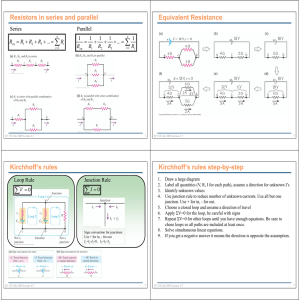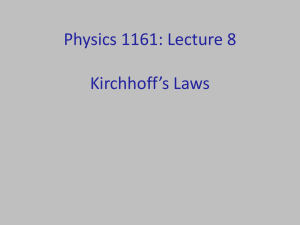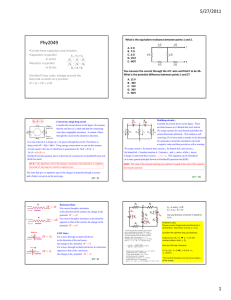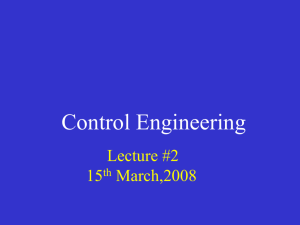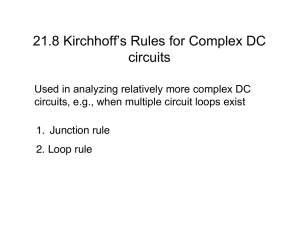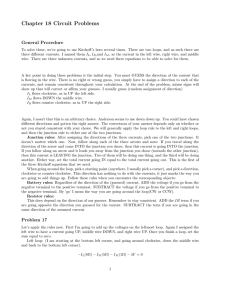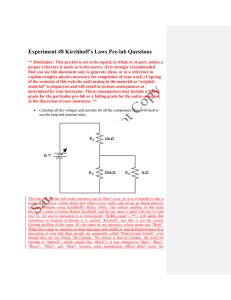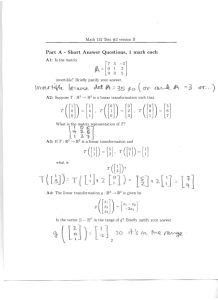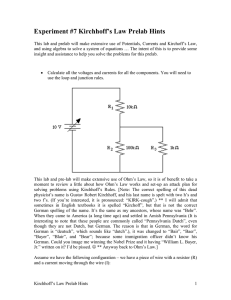Statement of Kirchhoff’s Rules Junction Rule
advertisement
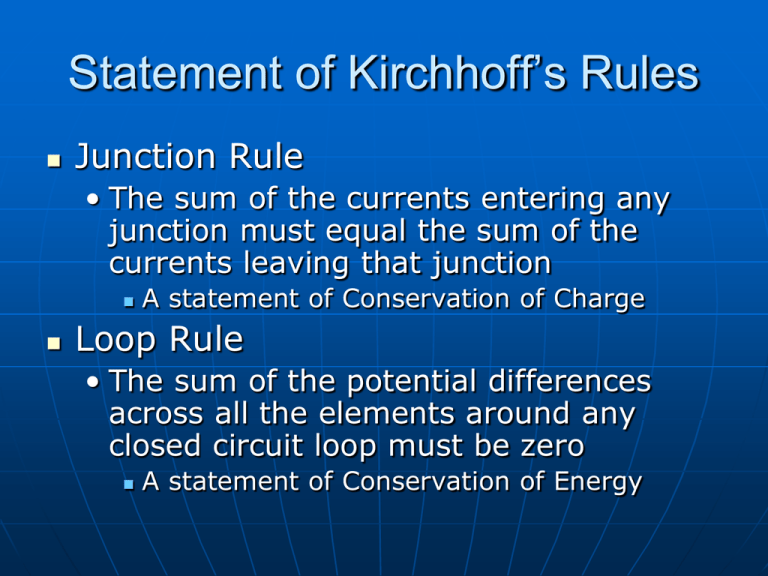
Statement of Kirchhoff’s Rules Junction Rule • The sum of the currents entering any junction must equal the sum of the currents leaving that junction A statement of Conservation of Charge Loop Rule • The sum of the potential differences across all the elements around any closed circuit loop must be zero A statement of Conservation of Energy Kirchoff’s Rules (1) Node rule, current law,.. I2 I1 = I2 + I3 I1 = I3 + IR1 IR2 R1 R2 V R3 I V V – IR1 – IR2 – IR3 = 0 V = I (R1 + R2 + R3) = I Req IR3 RECIPE (1) Indicate currents going through each circuit elements: * Realize that the same I flows through elements up to the junction points. * Make your best educated guess on the directions of I’s. (2) The currents are your unknowns. * You have to set up the same number of indep. Eqs. * At least one of them come from the I-law and the rest of them are from the V-law (3) Set up the appropriate loops and apply V-law for each loop. The direction of each loop can be either CW or CCW. * If the loop runs from (-) to (+) of a battery, the battery contributes (+) voltage (vice versa). * If the loop runs in the same direction as that of your current, the resistor contributes (-) voltage calculated from Ohm’s Law (vice versa). * Add all the contributions from the elements (R’s and batteries) in the loop will be set to “0”. 1 equation. ++ After all, if you get (-) current value, that simply means the current flows in the direction opposite to your guess. I3 I1, I2, and I3 3 unknowns 5 6V I2 3 I1 8V I1 = I2 + I3 6 – 5*I2 – 8 = 0 2 + 5*I2 = 0 6 – 3*I3 = 0 I3 = 2 A I1 = 1.6 A I2 = - 0.4 A This means that Your guess on the direction of I2 was wrong and actual current flows opposite direction. Does Ohm’s law say this? • Ohm: A liquid measure formerly used in Germany, varying locally between 30 and 36 gallons. • With the same potential drop (voltage) applied, the larger current flows through the smaller resistance. • With the same current flowing, larger potential drop develops across the larger resistance. • If the resistance is infinite, no current flows regardless of potential (voltage) difference across the resistor. • When there is no potential difference across an element, no current flows through regardless of the resistance. Example 21.3 40 3V 50 4V I1 10 5V I2 20 I3 30 I2 = I1 + I3 4 – 40I1 – 3 – 10I1 – 20I2 = 0 4 – 50I3 – 5 – 30I3 – 20I2 = 0 1 – 50I1 – 20I2 = 0 -1 – 80I3 – 20I2 = 0 Electrical Safety Electric shock can result in fatal burns Electric shock can cause the muscles of vital organs (such as the heart) to malfunction The degree of damage depends on • the magnitude of the current • the length of time it acts • the part of the body through which it passes Effects of Various Currents 5 mA or less • can cause a sensation of shock • generally little or no damage 10 mA • hand muscles contract • may be unable to let go a of live wire 100 mA • if passes through the body for 1 second or less, can be fatal Ground Wire Electrical equipment manufacturers use electrical cords that have a third wire, called a ground Prevents shocks Electrostatics and DC Circuit Revisited Prof. Ohm FIELD E = F/q F = qE Hmm, they can repel each other! V = IR R = V/I I = V/R

